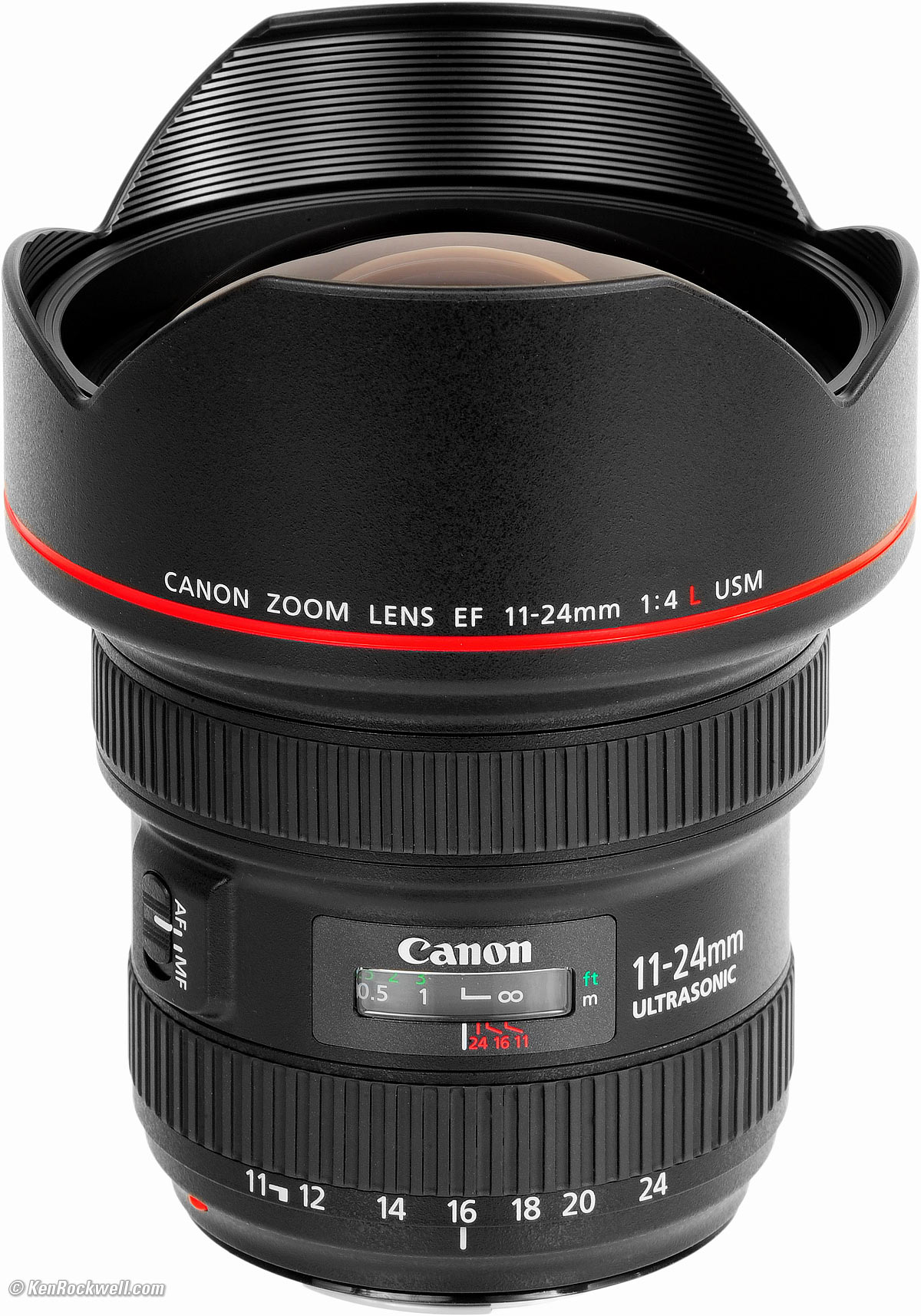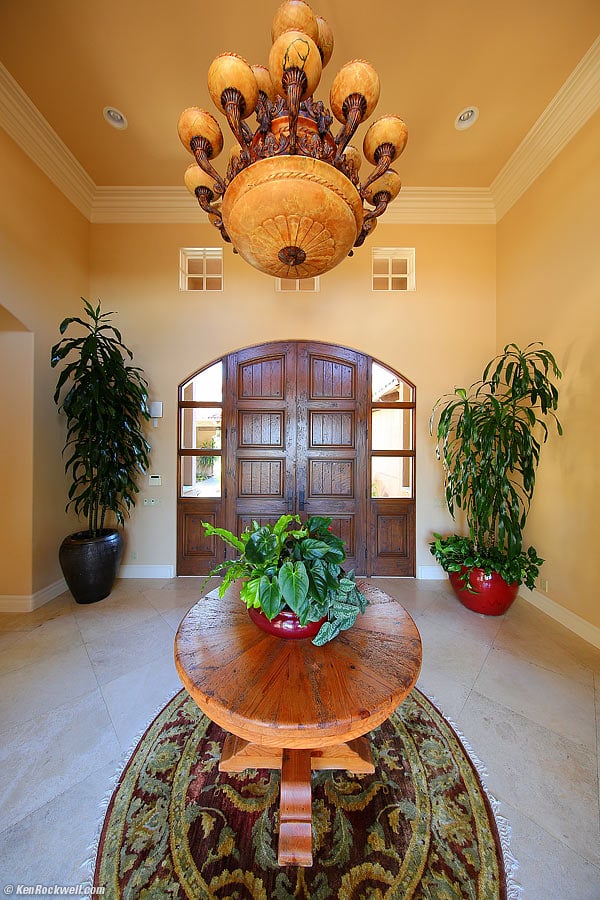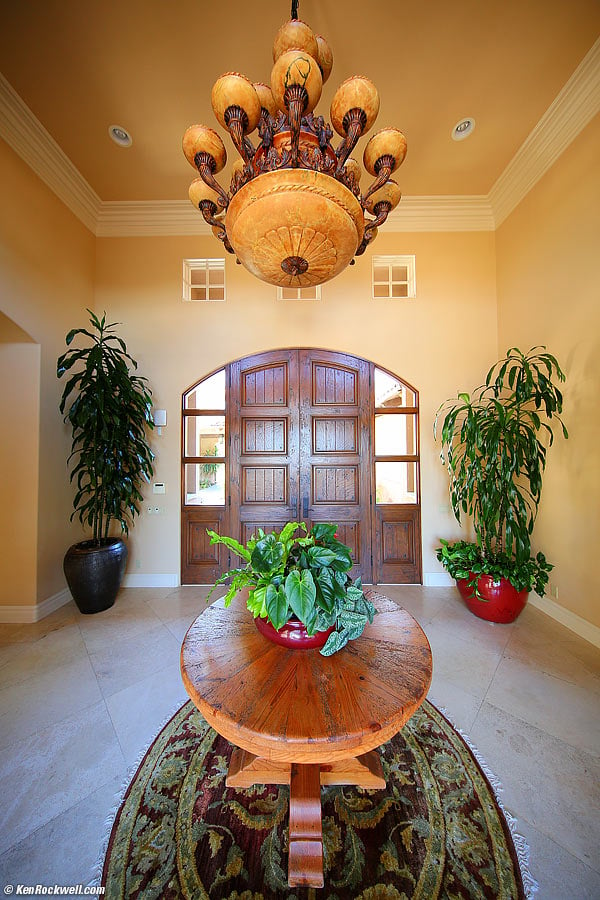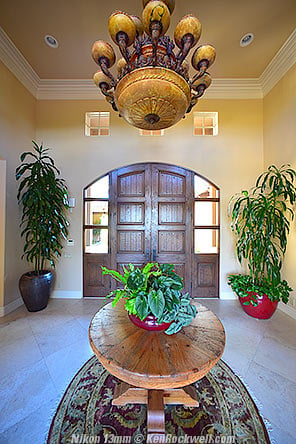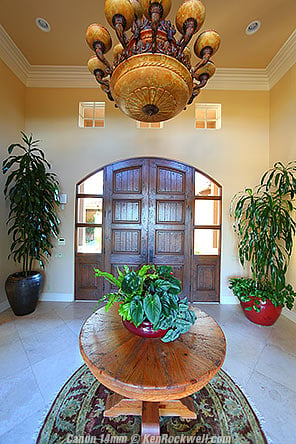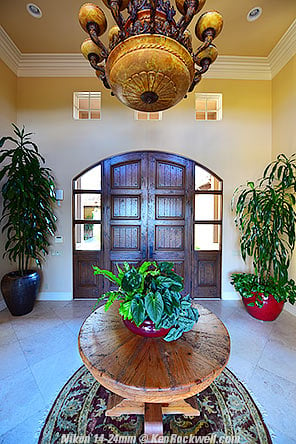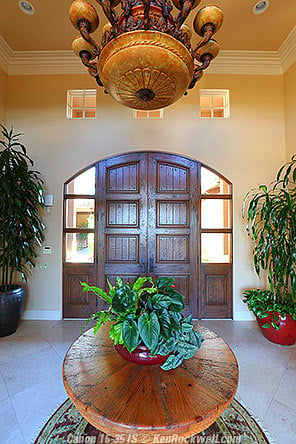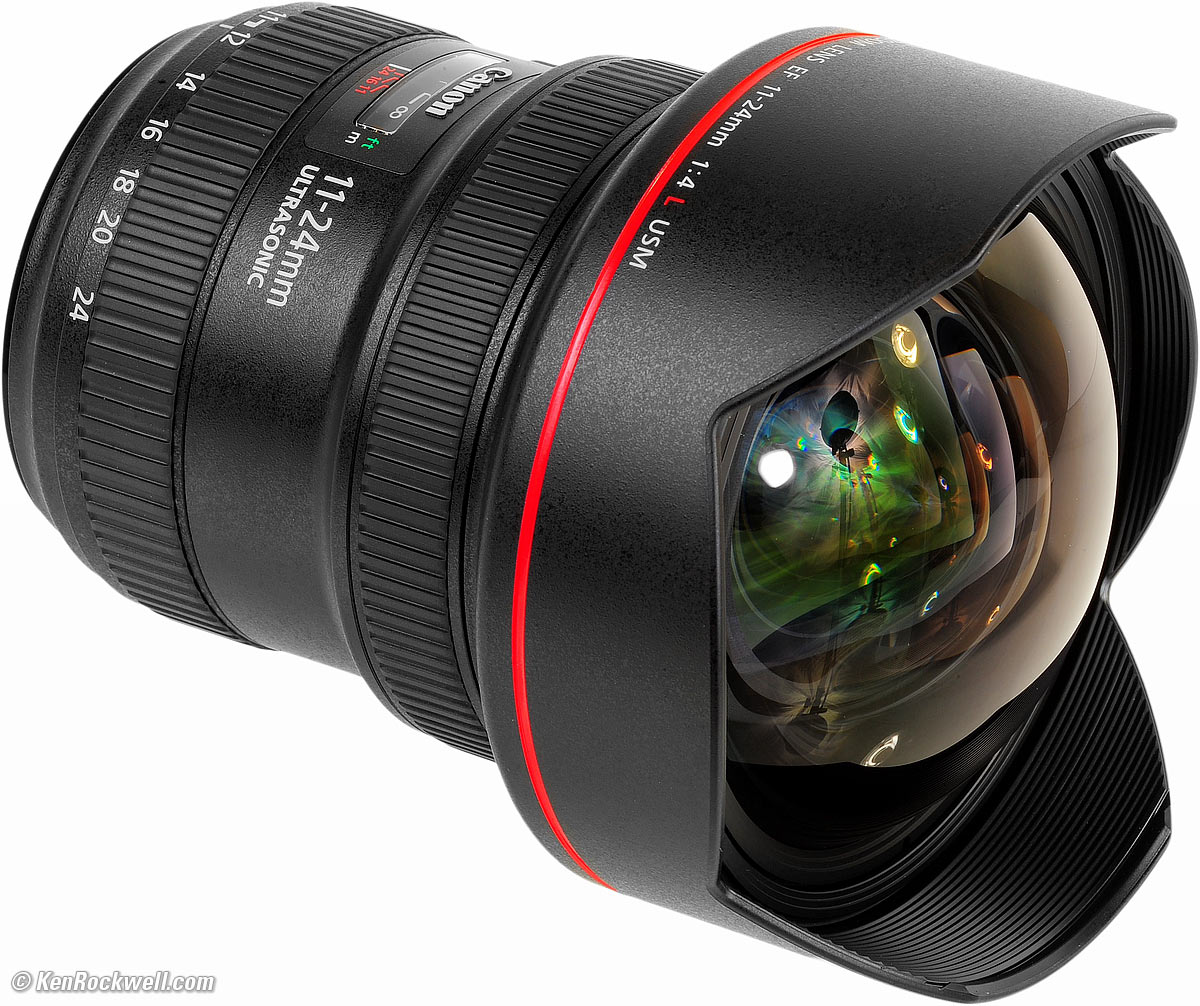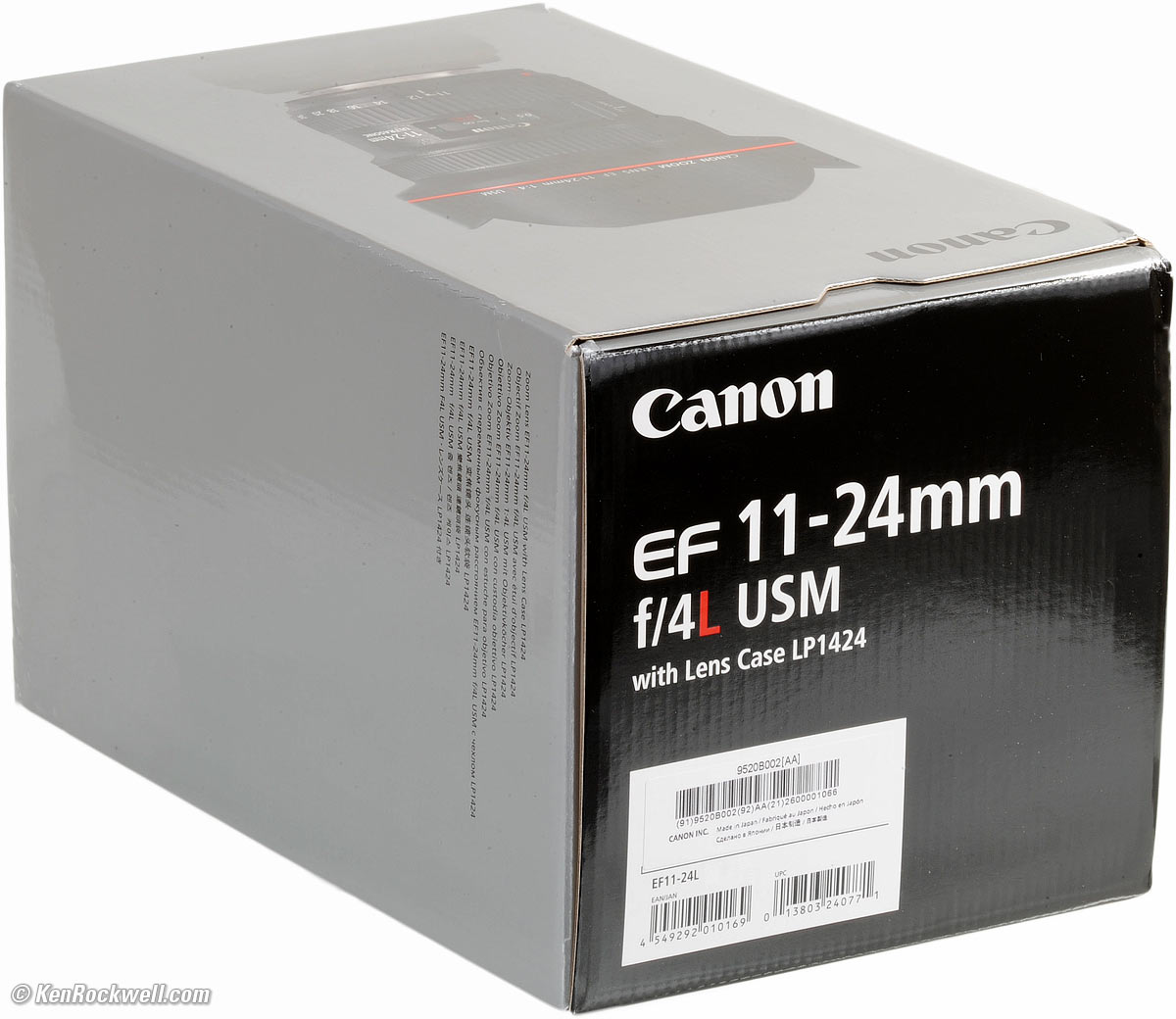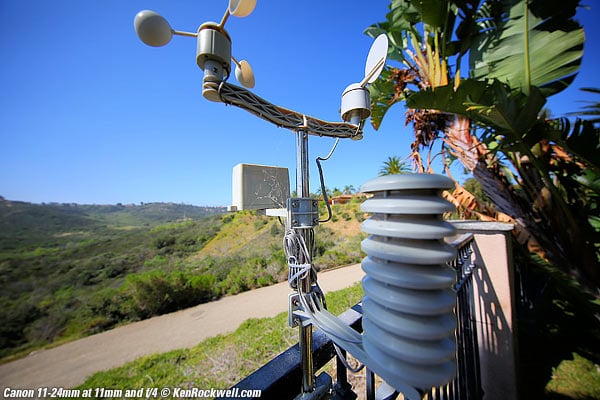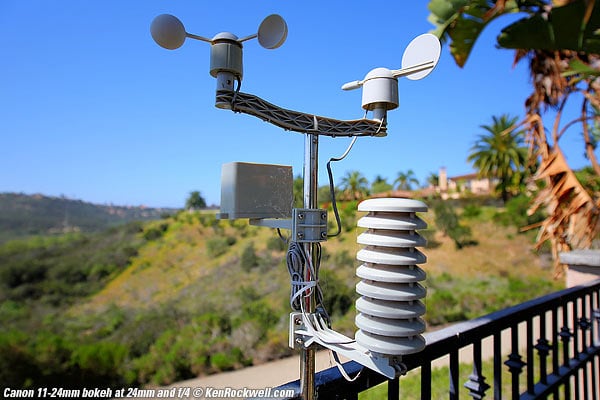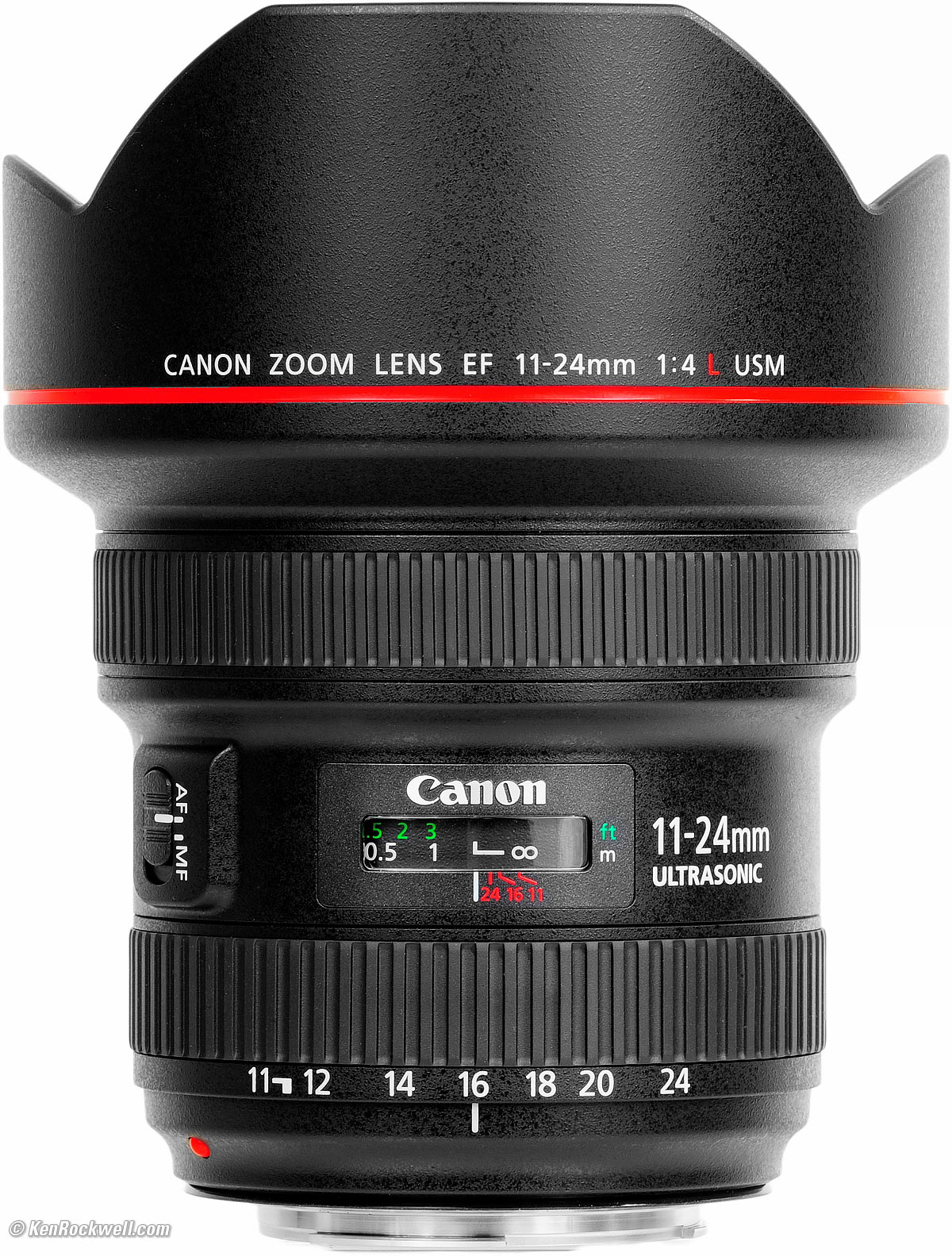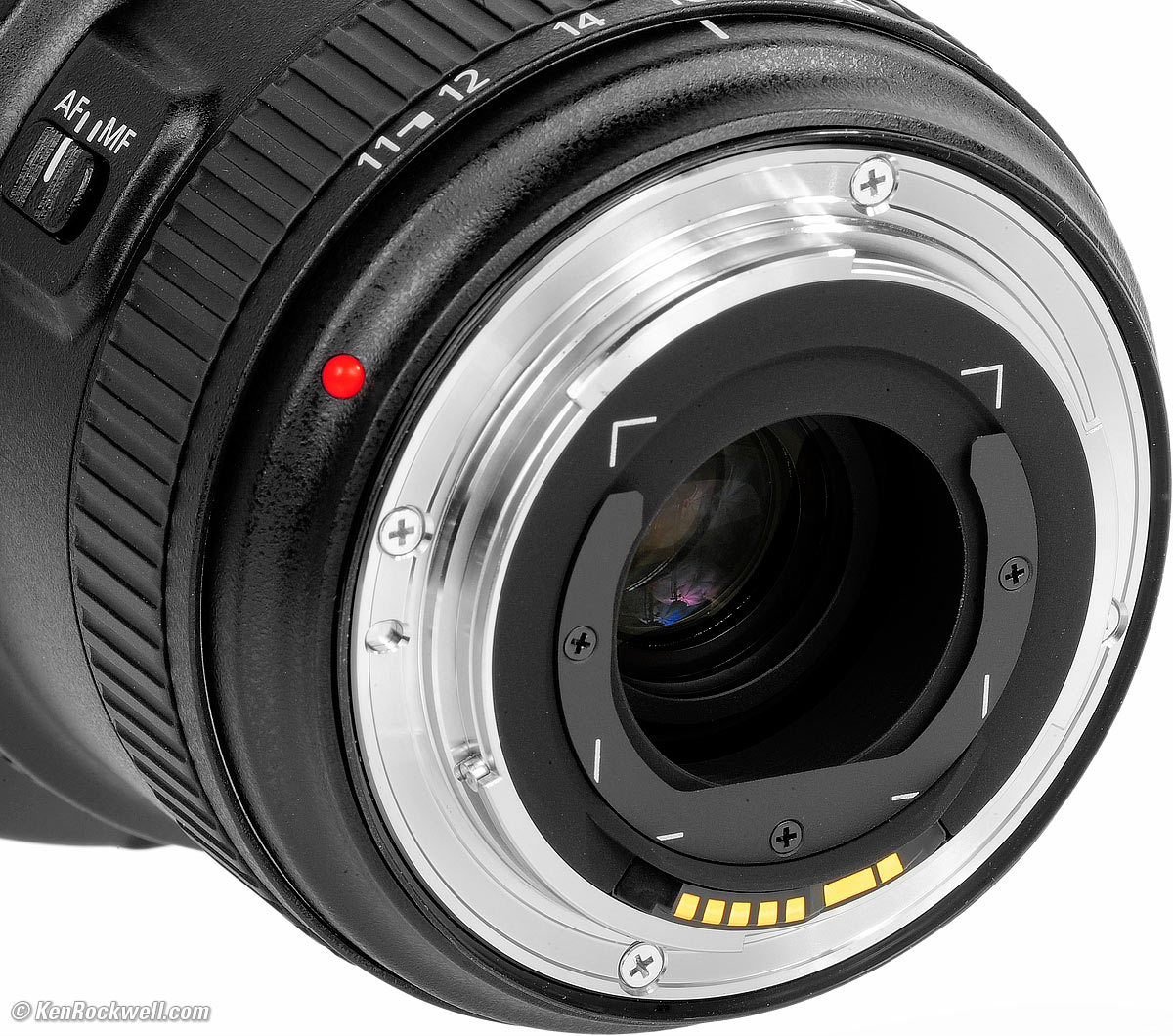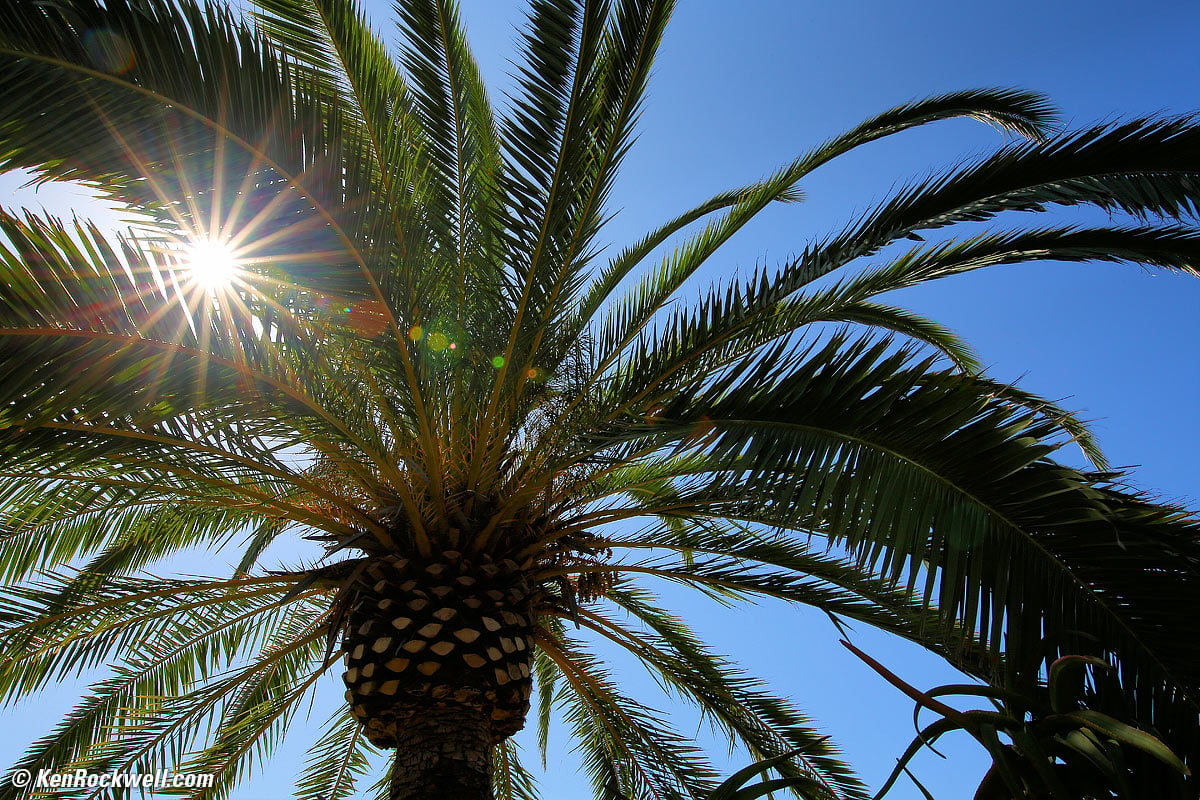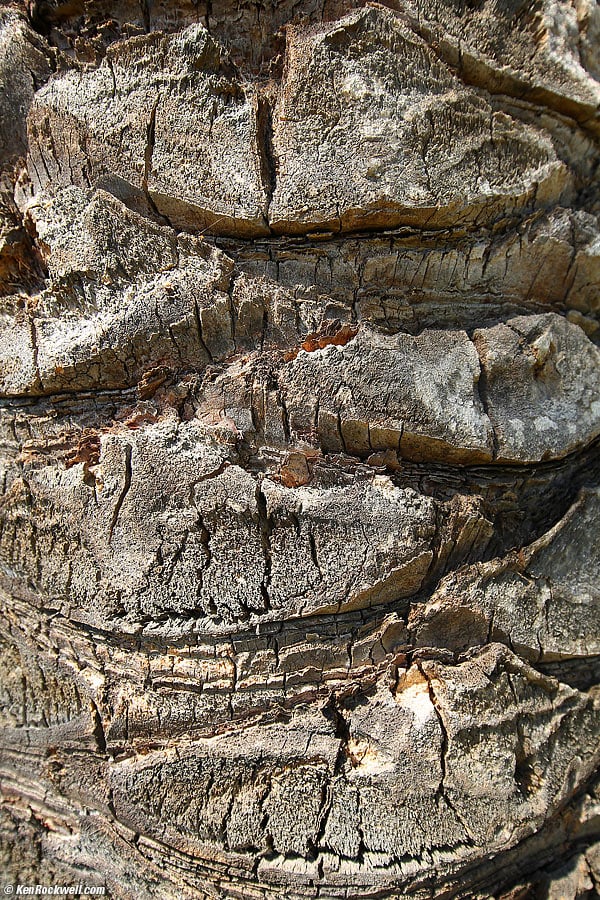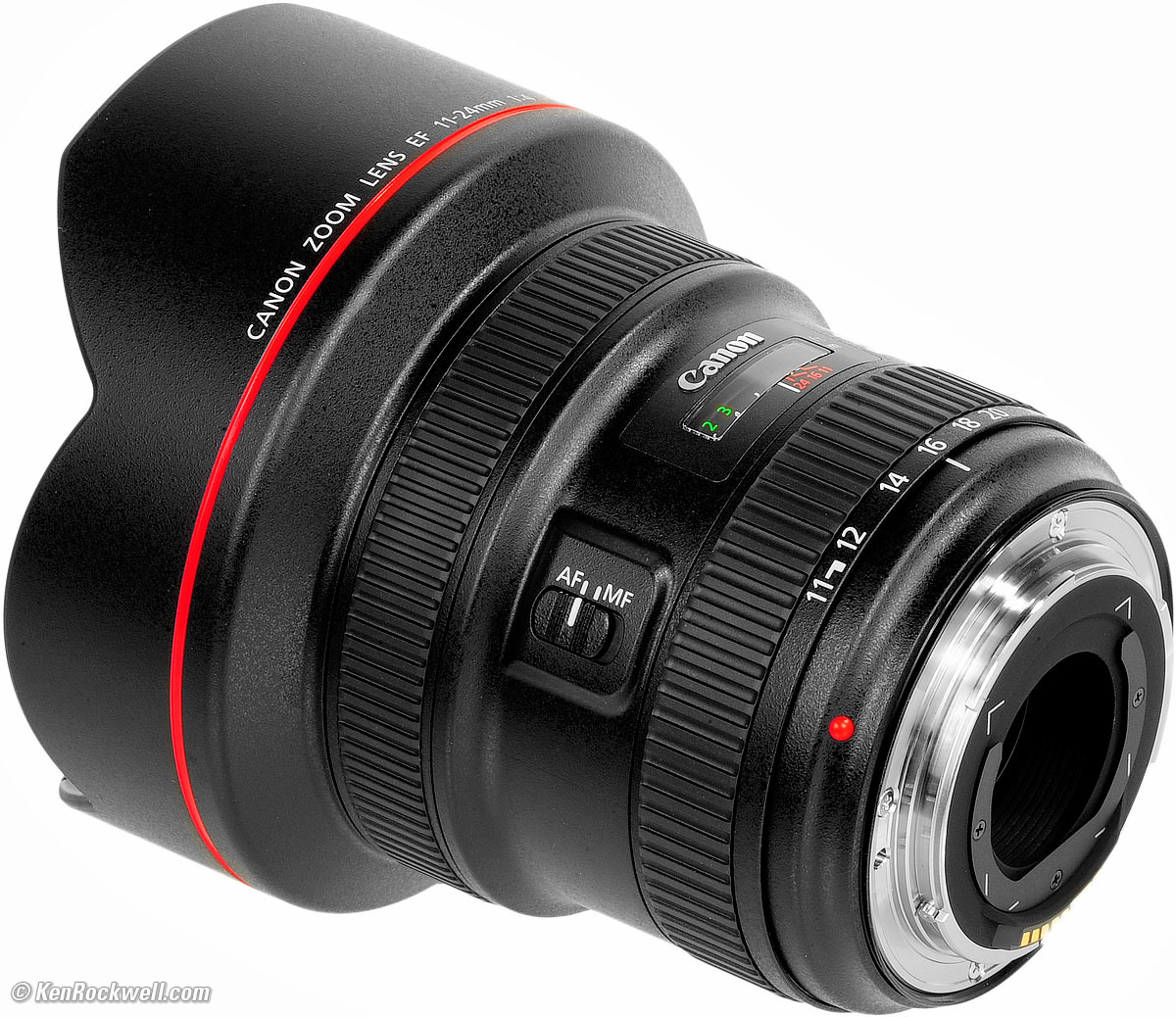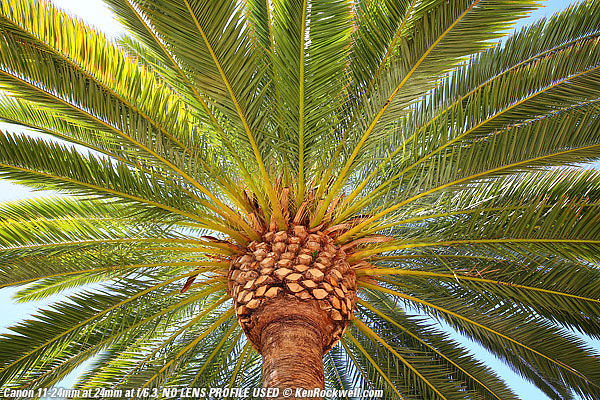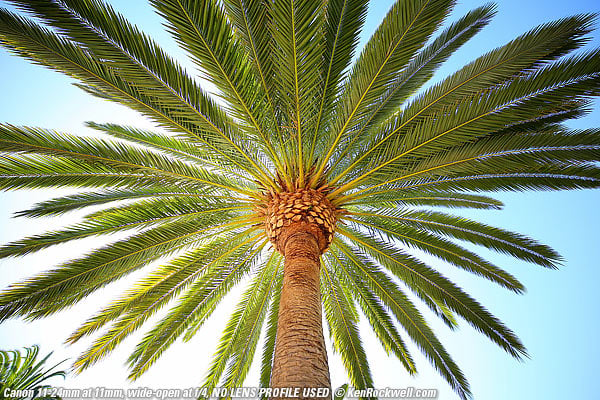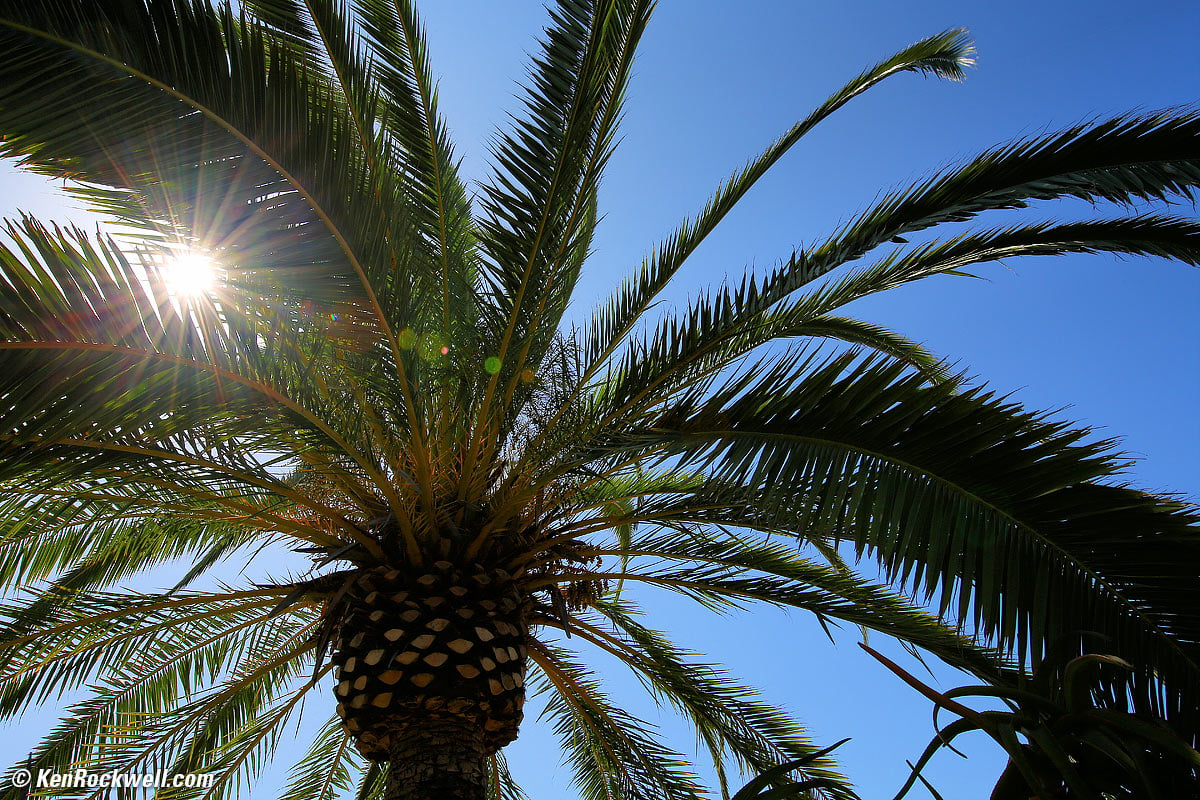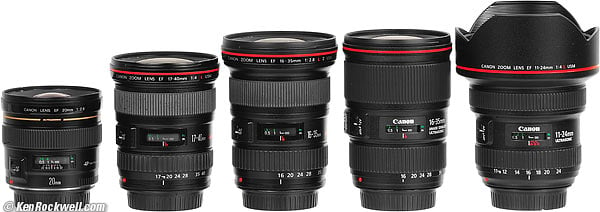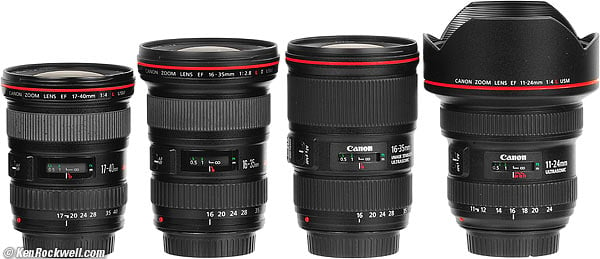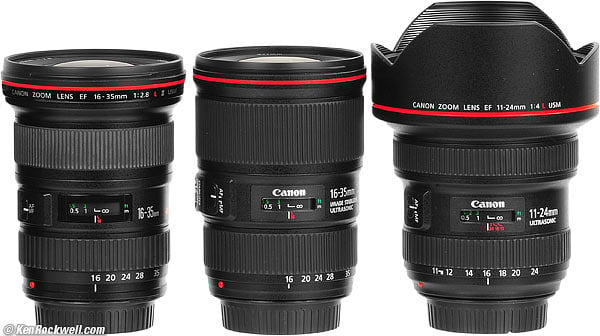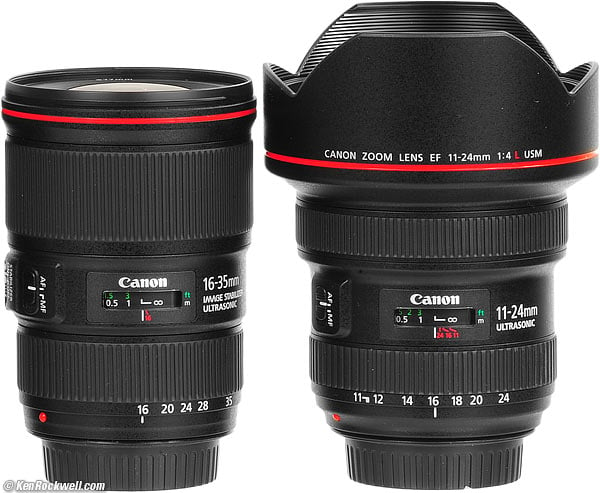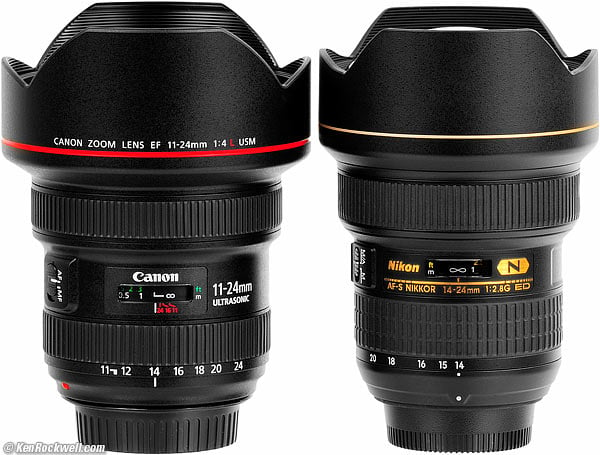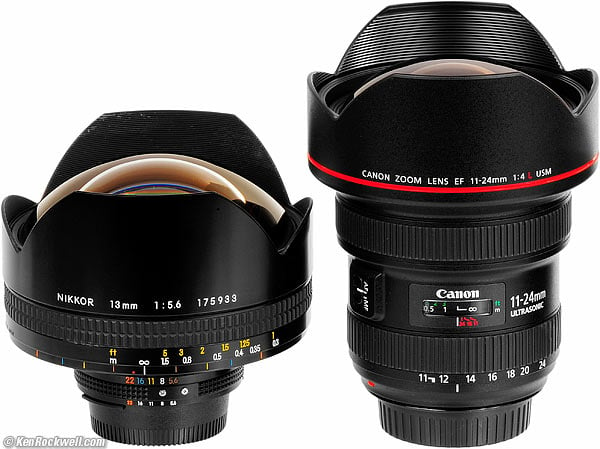Home Donate New Search Gallery Reviews How-To Books Links Workshops About Contact
Canon 11-24mm f/4 L
Full-Frame EF Ultra-Ultrawide (2015-)
World's Widest Ultra-Ultrawide: 126º
© KenRockwell.com. All rights reserved.
Sample Images Intro Specs Performance
Compared Usage Recommendations More
Canon EF 11-24mm f/4 L (Full-frame, 1.3x and and APS-C coverage, rear filters, 41.1 oz./1,166g, 11"/0.28m close focus, a bargain at about $2,699). enlarge.
I got mine at this link to it at Adorama, I'd just as well get it at Amazon or at B&H.
This all-content, junk-free website's biggest source of support is when you use those or any of these links to approved sources when you get anything, regardless of the country in which you live. Canon does not seal its boxes, so never, ever buy any lens, especially a lens like this that everyone wants to play with, at retail or any other source not on my personally approved list since you'll have no way of knowing if you're missing accessories, getting a defective, dropped, damaged or used lens, a customer return or if the warranty has already been registered to someone else online! (My approved sources ship from remote automated warehouses where no salespeople or lookie-loos can ever get their greasy fingers on your new lens.) Buy only from the approved sources I use myself for the best prices, service, return policies and selection. Thanks for helping me help you! Ken.
June 2017 Canon Lenses Canon Reviews All Reviews
How to Use Ultra-Wideangle Lenses
Full-Frame Ultrawide Lenses Compared
Sample Image Files (more throughout the review) top
Sample Images Intro Specs Performance
Compared Usage Recommendations More
Fine Home Entry. Canon 5D Mk III at ISO 250, 11-24mm at 11mm, f/8 at 1/8 hand-held, Perfectly Clear V2. Full-resolution file.
At 11mm, it can be hand-held at very slow speeds.
Know why you need 11mm? Because a lens this wide makes small homes look huge. In this shot, the dark door was only 11 feet (3.3m) away! You can see almost straight up and straight down. See the plant and chandelier? They're less than five feet (1.5m) away!
Fine Home Entry wide-open at f/4. Canon 5D Mk III at ISO 400, 11-24mm at 11mm, f/4 at 1/40 hand-held, Perfectly Clear V2. © camera-original file.
It's just as sharp wide-open (focus on plant in foreground). Even wide-open, the rug on the floor and the light fixture above are super-sharp, and falloff is no problem.
In fact, we usually want some falloff with ultra-ultrawides because we want to keep people's eyes in the picture, and not wandering off into the blank corners. In these examples, the wide-open version with uncorrected falloff is a better, more dynamic image.
These are all with NO lens profile; with a lens profile it will be even better and all the falloff goes away!
Here are shots made with the Nikon 13mm f/5.6, Nikon 14-24mm at 14mm, Canon 14mm f/2.8 L and Canon 16-35mm f/4 IS at 16mm for comparison. Click each to download the camera-original file. The Nikons were shot on a D810.
As you can see, no other lens comes close. The Nikon 13mm is almost wide, but even if it was as good, it costs eight times as much.
Introduction top
Sample Images Intro Specs Performance
Compared Usage Recommendations More
The Canon 11-24mm f/4 L is an extraordinary advance in lens technology because it's the world's widest ultrawide lens, and because it's super-sharp at every setting. There has never been a lens this wide, and the lenses that came close were much softer in the corners.
This is not a fisheye; straight lines stay straight. What little distortion it has is simple and easy to correct in Photoshop, and it has very little falloff for an ultrawide, so you don't even need to bother to load the latest lens profiles into your camera unless you want to. It has little to no lateral color fringes, so if you don't feel like using a lens profile — or are shooting on 35mm film — your images will still be spectacular.
Another huge advance for a Canon ultra-ultrawide is that it has a 9-bladed diaphragm, so for the first time in Canon history we can get 18-pointed sunstars instead of the bogus 6-pointed sunstars of Canon's 14mm lenses.
This is the world's most advanced ultrawide. Just look at the bizarre shapes of the reflections in the rear and the front three elements to see just how insane are the aspheres Canon is using in this lens. It's like nothing else on Earth.
Considering the incredible expense involved in the three huge and insanely aspherical front elements, I think Canon is losing money on these at $2,999.
This Canon 11-24 is a spectacular lens. It's the best ultra-ultrawide lens I've ever used. This Canon excels over all previous ultra-ultrawides because it's ultrasharp, even wide-open in the corners, and it has very little falloff and it has little distortion.
The most insane thing about this insane lens is how its images are sharp, colorful and contrasty just like a regular lens. The only way to appreciate what a landmark is this lens is if you've used ultra-ultrawides as extensively as I have (I use a Nikon 13mm f/5.6 and Nikon 14-24mm quite a bit), and realize just how fuzzy most ultra-ultrawides are. Canon's 14mm f/2.8 L II is awful, for instance.
If you're a nature, landscape or real estate pro, you need this lens to stay competitive. There is no other lens on Earth that can go this wide, and this lens is sharper than the other lenses that try to go this wide.
This lens is so wide that it can give you perspectives that your amateur competitors cannot get with their 14mm or 16-35mm lenses. This lens gets you even further into the territory that used to require a Nikon 13mm f/5.6, which sells for $24,000 today.
Considering how incomparable is this landmark lens, it's a steal at $2,999 for something of this caliber. Making a lens go to 11mm and cover full-frame involves an insane amount of engineering and manufacturing technology — which is why it's never been done before in the history of optics, especially for a zoom or SLR (retrofocus) lens.
Making a professional zoom that goes to 14mm or shorter is extremely difficult to near impossible. This Canon now leapfrogs every pro zoom and goes all the way to 11 (millimeters). With this lens, Canon has significantly pushed-out the performance envelope for SLR lenses — while Nikon has pretty much sat on its laurels for the past couple of decades in ultra-ultrawides.
This is a very special-purpose lens. For any sort of normal photography, the Canon 16-35mm f/4 IS L is smaller, lighter, takes normal screw-in filters and adds image stabilization — for half the price.
Just move the focus ring at any time for instant manual-focus override.
This lens is for the truly afflicted who really want to shoot wider than 16mm. Very few people know how to use ultra-wideangle lenses; ultra-ultra wides are the most difficult lenses to use well because they are the most sensitive to your position in three-dimensional space, and require you to get closer to your subject than most people ever do.
The most legitimate use of this lens is for real estate because it makes properties, both interior and exterior, look many times bigger than they actually are. If you shoot listings, I'm sure you already have yours on order.
The Canon EF 11-24mm f/4 L is so wide at 11mm that it's seeing you out the side! enlarge.
Behold The New King
The Canon 11-24mm with its forebears: the Nikon 13mm f/5.6 and the Canon 50mm f/1.0 L. grander.
For nearly 40 years since 1976, the Nikon 13mm f/5.6 was the world's widest professional SLR lens. This Canon now goes far wider, and it's faster, sharper and far less expensive.
Likewise, the Canon 50mm f/1.0 L has been (and still is) the world's fastest SLR lens; Canon's unsurpassed super-lens that you can use every day.
This Canon 11-24mm now inherits the lofty seats of each. It neatly replaces the Nikon 13mm with wider and better performance, and also is the direct inheritor of the 50/1's reputation as The Eye of the Professional: a lens so advanced that nothing else compares.
While Canon's super-teles cost more, the 11-24mm, like the 50mm f/1, is a reasonably sized lens that you can use and carry every day.
Formats and Compatibility
This works on all Canon EOS cameras, meaning all Canon DSLRs and all Canon 35mm EOS autofocus SLRs all the way back to the 1987 EOS 650. Yes, I tried it on my 1987 EOS 650 and it works perfectly.
While it works on small format digital cameras, this is a full-frame lens and it is foolish to buy it for use on a Canon APS-C camera. For these cameras, the Canon 10-18mm EF-s is just as sharp goes wider and and takes normal filters, for one-tenth the price.
This is a superior full-frame lens, and as such, I'll be testing it on full frame. The reason it costs $3,000 instead of $300 is precisely because of the extreme engineering challenges that took over 100 years to overcome — for full frame. We've had APS lenses in this focal length for a decade, but for full frame, this is a world's first.
Specifications top
Sample Images Intro Specs Performance
Compared Usage Recommendations More
Name
Canon calls this the CANON ZOOM LENS EF 11-24mm f/4 L USM.
EF means "electronic focus;" there is an autofocus motor inside the lens.
L means as expensive as L.
USM (Ultra-Sonic Motor) means that the focus motor operates reasonably silently.
Optics top
Canon EF 11-24mm f/4L internal diagram. Aspherical, Super UD Glass, UD Glass and glass.
16 elements in 11 groups.
Four are aspherical: the first three huge front elements and the rear element.
One is of Super UD glass and one is of UD glass, designed to increase sharpness and eliminate secondary color fringes.
Subwavelength Coating (SWC), a.k.a. Air Sphere Coating (ASC). It's the same as Nikon's nano coating, which is even better than multicoating at reducing reflections.
The front and back groups move in and out as zoomed.
Fluorine outer coatings to make cleaning much easier.
Focal Length
11-24mm.
When used on an APS-C camera, it sees an angle of view similar to what an 18-40mm lens sees when used on an FX or 35mm camera.
Angle of View, full frame
126.08º ~ 84.00º diagonal.
117.17º ~ 74.00º horizontal.
95.0º ~ 53.0º vertical.
Diaphragm top
Canon 11-24mm f/4L at f/4. (EF diaphragm not visible). enlarge.
9 circular blades.
Stops down to f/22.
Close Focus top
Specified
11 inches (0.28m) from the image plane at 24mm.
11.4 inches (0.29m) from the image plane at 16mm.
12.6 inches (0.32m) from the image plane at 11mm.
Measured
10.25" (0.26m) from the image plane at 24mm.
3.25" (8 cm) from the front of the lens!
Maximum Reproduction Ratio top
1:6.25 (0.16 x) at 24mm.
1:10 (0.10 x) at 16mm.
1:16.7 (0.06 x) at 11mm.
Minimum Subject Field top
24mm: 74 x 112mm (2.91 x 4.41") at 0.28m/11."
11mm: 196 x 307mm (7.72 x 12.09") at 0.32m/12.4."
Hard Infinity Focus Stop? top
No.
Focus Scale top
Yes.
Depth-of-Field Scale top
No.
Infra-Red Focus Indices top
Yes, for 800 nm.
Filters top
Rear-attached only.
Extension Tubes top
See the Extension Tubes section under Performance.
Size top
Canon specifies 4.25" (108.0 mm) diameter by 5.20" (132.0 mm) extension from flange.
Weight top
Mine weighs 41.130 oz. (1,166.0 g.).
Canon specifies 41.6 oz. (1,180g).
Hood top
None; the plastic petals are mostly to protect the front element from your fingers or banging into things.
Front Cap top
Canon 11-24 front lens cap. bigger.
It has a special dedicated front cap, logically called "11-24," and takes the standard EOS rear cap.
The front cap weighs 1.600 oz. (45.3g).
This front cap is dinky plastic garbage. Worse, it's so short it only barely covers the scallops of the hood, and coupled with the holes for the catches, doesn't really seal out dust — whoops!
You have to align it to fit the petals when you attach it.
The good news is that it clamps tightly, but Canon should provide a velvet lined, deep solid billet aluminum cap that pushes on and seals tight, as Nikon does for its 13mm and 15mm lenses, and as Canon does for its first 14mm lens.
Canon could have used a genuine leather drawstring front lens cover or a real felt-lined metal cap for this $3,000 lens, but no.
Case top
LP1424 sack included.
It's also crummy; just a flimsy unpadded sack. Why do they bother; it cheapens the lens to include a crummy sack instead of nothing at all or a real padded case.
Announced top
Thursday, 05 February 2015, 11 PM NYC time.
Available top
Late February, 2015.
Canon Model Number top
EF11-24L.
9520B002. (9520B001 in Japan.)
EAN/JAN top
4549292-010169.
UPC top
0 13803 24077 1.
Packaging top
It comes in a silver-gray microcorrugated cardboard box:
Box, Canon EF 11-24mm f/4L. bigger.
Inside this box are the usual paperwork, and two assemblies of engineered white closed-cell foam. The lens sits in the bottom section, and the front cap and sack sit separately on top:
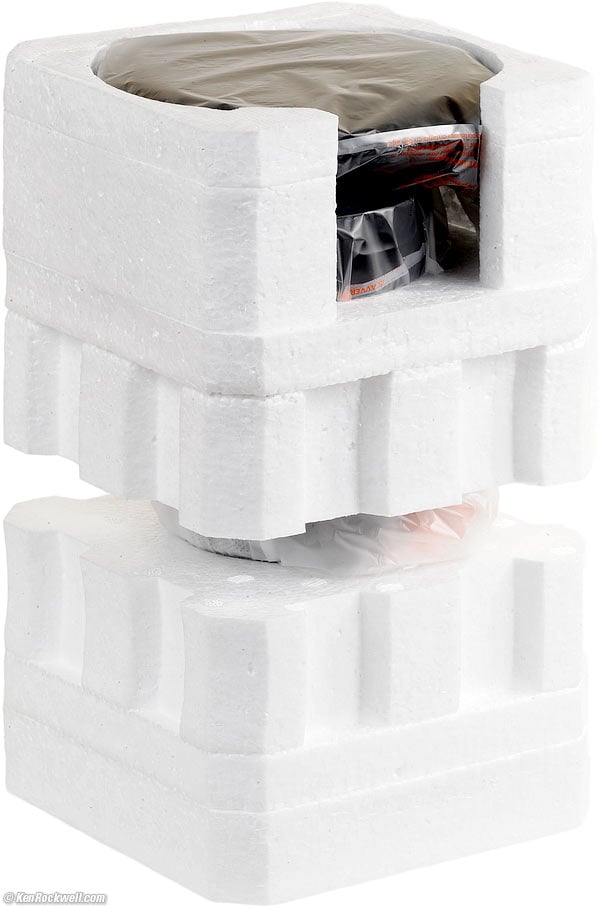
Packing, Canon EF 11-24mm f/4L.
Hold on — I said the front cap is packed on top? So what's covering the front of the lens?
When you pull off the top piece of foam, you'll discover that Canon has shipped the lens with a second "shipping cap," which is a thin, clear cap whose purpose is primarily to keep dust-resistant white gauze tightly around the front of the lens.
Save this shipping cap, gauze and sack in the box for when you have to ship it. Put on the front cap, and you're ready to go.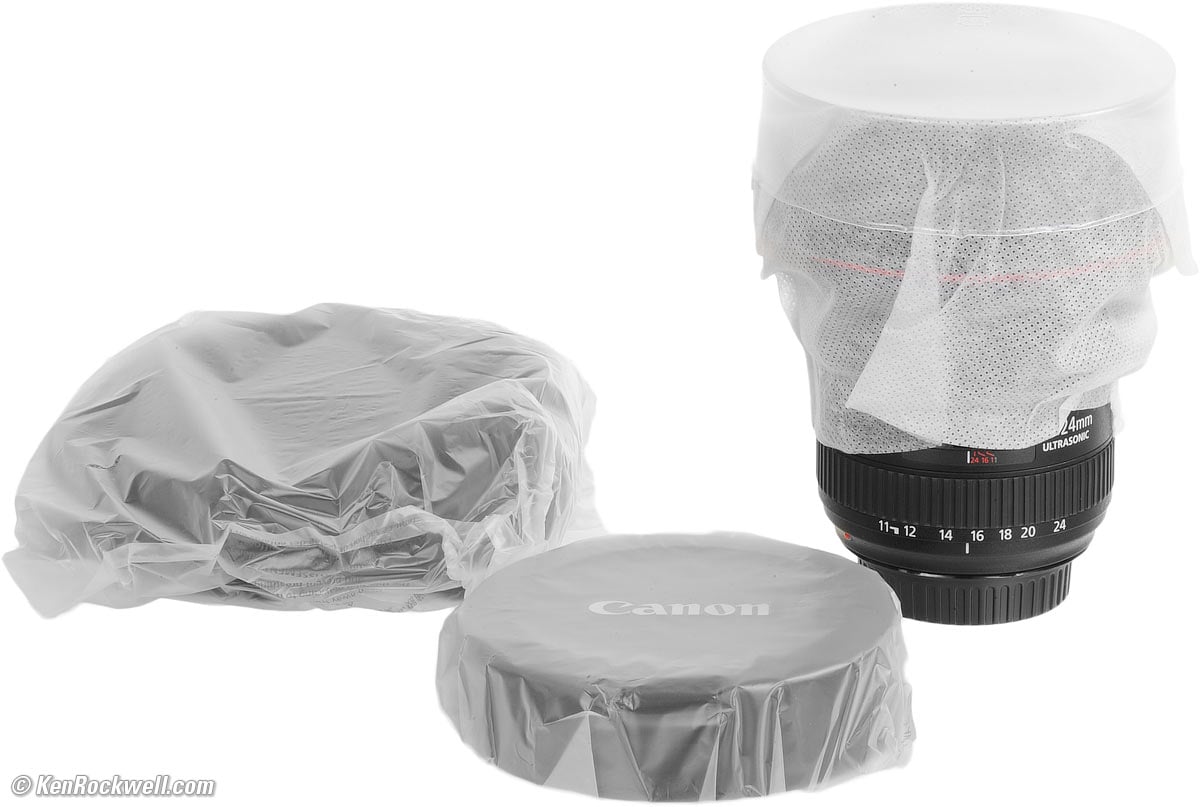
Included sack, separate front cap, shipping cap and EF 11-24mm f/4L. bigger.
Price, USA top
June 2017: $2,699.
2015 February~July : $2,999. ($450,000 yen in Japan.)
Performance top
Sample Images Intro Specs Performance
Compared Usage Recommendations More
Distortion Ergonomics Extension Tubes
Falloff Filters Flare & Ghosts Focus Breathing
Lateral Color Fringes Macro Mechanics
Overall performance top
The 11-24mm is a magnificent lens. Not only is it the world's widest lens, it's also super-sharp and reasonably free from distortion. Other ultra-ultra wide lenses are not this sharp.
This breakthrough lens brings lenses of 15mm and wider into the third millennium. With lenses this good and this practical, people of the future will have forgotten just how awful were all the ultra-ultrawide lenses before this. Before this lens arrived on my doorstep in March 2015, the only other really good 15mm or wider lens was my Nikon 14-24mm.
Focus performance top
Autofocus
Autofocus is the same as every other wide angle: fast. No news here.
Autofocus Accuracy
Autofocus is always dead-on.
Auto/Manual Switching
Just grab the ring anytime for instant manual-focus override.
There's also a switch, like every other Canon lens.
Manual Focus
Manual focus is slow and precise.
Not much happens when turning the manual focus ring of any ultrawide, and this is no different.
Bokeh performance top
Bokeh, the quality of out-of-focus areas as opposed to the degree of defocus, is swell, but you've got to be kidding me: with a lens this wide, you'll almost never have anything far enough out of focus to care.
Bokeh is very smooth in the center, and isn't that much worse in the sides, which is saying a lot for an ultra-ultra wide lens. Other lenses that try to be this wide start doing very weird things in the corners and have much worse bokeh than this Canon 11-24.
Here are full-frame samples. Click for the camera-original JPG:
Canon 11~24mm at 11mm and f/4. Camera-original © file.
Canon 11~24mm at 24mm and f/4. Camera-original © file.
Coma performance top
There is no coma.
It's sharp right out to the corners, even at f/4. Wow.
Distortion performance top
The 11-24mm L has much less distortion than expected for such an insane lens. In fact, it has less distortion than ordinary ultrawide zooms like the 16-35/4 IS!
The distortion is invisible between 14~24mm, and only moderate at 11mm. Even at 12mm the barrel distortion is less than most lenses at their widest setting!
Use these factors to correct the distortion in Photoshop's lens distortion filter. These aren't facts or specifications, they are the results of my research that requires hours of photography and calculations on the resulting data.
More good news is that the distortion is simple first-order distortion, so these simple corrections correct the distortion completely. The distortion isn't complex and difficult to correct as distortion in older lenses used to be. Bravo!
at 3m (10 feet): |
On full-frame and 35mm |
11mm |
+3.50 |
12mm |
+2.45 |
13mm |
+1.60 |
14mm |
+1.30 |
15mm |
+0.80 |
16mm |
±0.00 |
17mm |
±0.00 |
18mm |
±0.00 |
20mm |
-0.90 |
24mm |
-0.90 |
© 2015 KenRockwell.com. All rights reserved.
Ergonomics performance top
Canon EF 11-24mm f/4 L USM. bigger.
Ergonomics are great. Focus and everything are great, and your fingers won't get in the way due to the big front.
Manual focus moves with just a fingertip.
See also Zooming.
Extension Tubes performance top
Canon suggests not using manual focus with extension tubes.
Canon EF-12 (12mm long)
You can use the Canon EF-12 or Canon EF12 II.
It will give you a focus range from 188 to 203 millimeters (7,4 to 8.0 inches) from the image plane, and give you a magnification range from 0.53x to 0.73x.
The tube works best at 24mm and won't work at 11mm.
Canon EF-25 (25mm long)
The Canon EF-25 or Canon EF25 II doesn't work with this lens. You'd be focused inside the lens!
Falloff (darkened corners) performance top
Falloff is visible at f/4 and gone by f/5.6, even without a lens correction profile.
I've greatly exaggerated this by presenting it against a gray background. In actual photography, it's completely invisible except at f/4.
Canon 11-24mm falloff on full-frame, no correction.
© 2015 KenRockwell.com. All rights reserved.
|
I like this falloff with ultrawides because it adds to the drama; if you don't want falloff, use a lens profile.
Even without a profile, this is very little falloff for a lens this wide.
Filters, Use with performance top
Rear gel slot with cutting guide, Canon 11-24mm f/4L. enlarge.
There is no way to attach filters to the front, either as grads or for protection, or for anything else.
You can attach gel filters to the rear. Canon provides a slot. The white corners are cutting guides.
Canon's instructions say don't shoot as wide as 11mm with a gel filter in place, but I don't see any interference on my 11-24mm.
Flare and Ghosts performance top
With three huge bulging front elements, light goes in and bounces around far more than with any other sort of lens.
Canon uses all sorts of spook-level coatings where it needs to, but there are still some ghosts and also some odd flare.
Here's a image also shown at Sunstars, and you can see a nice family of ghost dots all in line following the sun. I like this with ultrawides because they help show just how bright is the sun. In this case, I'm shooting directly into the disc of the sun and using the dark tree to let us see the ghosts.
Canon 11-24mm f/4 L ghosts at f/22. bigger.
You won't see these ghosts unless you go out of your way as I did here to conjure them.
A different kind of ghost unique to ultra-ultrawide lenses are the ones that come from the light bouncing all around inside the huge front elements. This lens sees out the sides, so if you shoot with bright areas (like windows seen from interiors) outside your frame, you may see some dim green blobs in the dark parts of your image.
These are easy to eliminate: just use your hand to block your lens. The Nikon 15mm f/3.5 has the worst cast of this; I made a custom shade for it. This Canon doesn't really have a problem, but if you do see them, just use your hand to block bright areas outside the image from hitting the lens.
Focus Breathing performance top
Focus breathing (the image changing size as focused) is mostly of interest to cinematographers who don't want the image changing size ("breathing") as the lens is focused among different subjects.
The image from the 11-24 gets slightly smaller as focussed more closely. That's right: it gets wider at close distances. Insane!
Lateral Color Fringes performance top
There are little to no lateral color fringes, even without a lens profile on full frame.
This is superb!
If they bother you, use a lens profile.
Macro performance top
This lens focuses to 0.28m (11") from the image plane, but the lens is so huge that this means it focuses to just a few inches (8cm) from the front of the lens!
This dosn't seem very close because it's so wide. It is sharp, even at f/4:
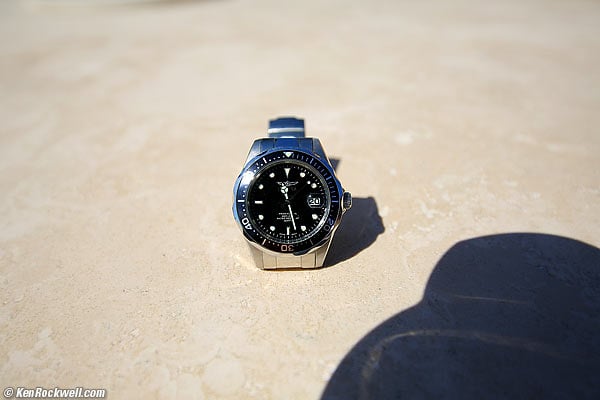
At close-focus distance at f/4 at 24mm on full-frame, Canon 11-24mm f/4 L .
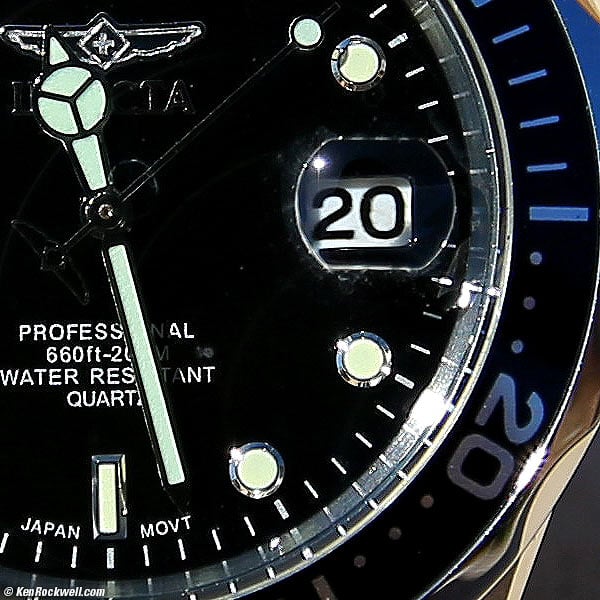
Crop from above image at 100%, shot at f/4 at ISO 100 on a 5D Mark III. If this is 6" (15cm) wide on your screen, the full image would print at 40 x 60" (1 x 1.5 meters)!
Palm Trunk. Canon 5D Mk III at ISO 100, 11-24mm at 24mm, f/7.1 at 1/100. © camera-original file. Of course only the line down the center is in focus; the tree is round and the sides of the photo are not in focus.
This is with no lens profile; any slight lateral color will go away with a profile.
Mechanics performance top
Rear, Canon EF 11-24mm f/4 L USM. bigger.
The Canon 11-24mm f/4 L is made reasonably well. The "hood" is tough plastic, so it will bounce rather than dent.
Weather Sealing
The lens mount, focus and zoom rings are somewhat sealed, but the front optical group moves in and out as zoomed, and I don't believe that it's sealed — so watch it in the rain.
Honestly, as soon as you get one drop on the front element you'll see it in your images. I have to use Photoshop to spot them out. I suspect you'll give up shooting as the front elements gets wet long before there's any danger of flooding your lens.
Hood Petals
Tough plastic.
Identity
Printed around of front of lens.
Forebarrel
Plastic.
Focus Ring
Metal, rubber covered.
Internals
Looks like all metal.
Mid Barrel
Plastic.
Zoom Ring
Metal, rubber covered.
Rear Barrel
Plastic.
Mount
Metal.
Markings
Painted.
Serial Number
Laser-engraved into bottom of barrel just above the regulatory symbols.
It's black-on-black, so you won't see it unless you're looking for it.
Date Code
None found.
Rear Gasket (moisture seal at mount)
Yes.
Noises When Shaken
Mild, soft clunking.
Quality
Made in Japan.
Sharpness performance top
Image sharpness depends more on you than your lens, and lens sharpness doesn't mean much to good photographers. It's the least skilled hobbyists who waste the most time blaming fuzzy pictures on their lenses, while real shooters know that few photos ever use all the sharpness of which their lenses are capable due to subject motion and the fact that real subjects are rarely perfectly flat.
This caution aside, this is an incredibly sharp lens. No lens this wide has ever been this sharp.
This 11~24mm is astounding. Every other 14mm lens is pretty bad at the sides, but that's all we have had these past 40 years, while this new Canon lens finally gives us images as sharp as our other lenses. The Nikon 14-24mm is also very sharp, but it goes no wider than 14mm. Every other 15mm and wider lens is much softer than this 11-24mm.
This lens is sharp in the corners, even at 11mm wide-open at f/4. I haven't used a lens profile, when I do, it will get even better.
Palm, 20 March 2015. Canon 5D Mk III at ISO 100, Canon 11-24mm at 24mm, f/6.3 at 1/80 hand-held, Perfectly Clear V2. Full-resolution file.
It's super-sharp at 24mm, but so what, we don't need to spend $3,000 to get to 24mm. Let's see how it looks at 11mm:
Palm, 20 March 2015. Canon 5D Mk III at ISO 100, Canon 11-24mm at 11mm, f/7.1 at 1/100, Perfectly Clear V2. Full-resolution file.
AHA! It's brilliant at 11mm, a setting so wide no other rectilinear (flat or straight) lens can duplicate. It's sharp right out to the edges, something only one other ultra-ultrawide can do (the Nikon 14-24mm), but that Nikon can't get anywhere near as wide. The lateral color fringes will go away with a lens profile. (The palm in the lower left is much farther away and not in focus.)
So far, so good. Let's put it to the acid test: let's see how good it is wide-open at 11mm, where it should be the softest. This is the money shot:
Palm, 20 March 2015. Canon 5D Mk III at ISO 100, Canon 11-24mm at 11mm, wide-open at f/4 and 1/160, Perfectly Clear V2. Full-resolution file.
AHA!!! It's also brilliantly sharp wide-open at 11mm, which is insanely good. It also doesn't have much falloff, which again is unheard of in a lens this wide — if there were any other lenses this wide. Again, the lateral color fringes and falloff will go away with a lens profile. No lens on Earth is this wide, much less this sharp and clear. (The palm in the lower left is much farther away and not in focus.)
These MTF curves confirm what I see when I shoot my 11-24mm: it's very contrasty and sharp at every focal length and aperture setting:
Canon EF 11-24mm f/4 L MTF Curves.
WARNING: I bought mine from Adorama, who like my other Approved Sources, ships from a secure, remote automated warehouse nowhere near its retail store. I use Approved Sources so I know that the lens I receive has never been taken out to show around on the sales floor, and no other customer or salesman has ever had his hands on it. No store employee has "borrowed" it for a weekend to try it out at home. No one has dropped it, either. When I buy from my favorite stores, I know that I have a pristine, untouched, unopened and brand-new lens. DO NOT buy this lens from any retail store because something as remarkable as this lens will undoubtedly have been taken out and shown around many times before you buy it. Everyone wants to look through this lens, so if you're foolish enough to buy one at retail, God help you because Canon does not seal anything about its boxes, so if bought at retail you will have no idea of where it's been, since salespeople and managers have open access to their stockrooms.
If you buy from other than an approved source, yours may or may not be this good. The short focal lengths of ultrawide lenses demand much tighter mechanical tolerances to maintain sharpness compared to other lenses, so even the slightest bang on a camera store counter that leaves no marks on the lens could make it less sharp. Beware.
Sunstars performance top
While Canon says the 11-24mm f/4 has a rounded diaphragm, thank goodness it straightens out stopped-down to make nice 18-pointed sunstars on brilliant points of light.
With its 9-bladed diaphragm, this Canon 11-24mm f/4 makes soft or no sunstars at wide apertures, and nice 18-pointed sunstars on brilliant points of light only at about f/22:
Canon 11-24mm f/4 L sunstar at f/8. bigger.
Canon 11-24mm f/4 L sunstar at f/11. bigger.
Canon 11-24mm f/4 L sunstar at f/16. bigger.
Canon 11-24mm f/4 L sunstar at f/22. bigger.
Zooming performance top
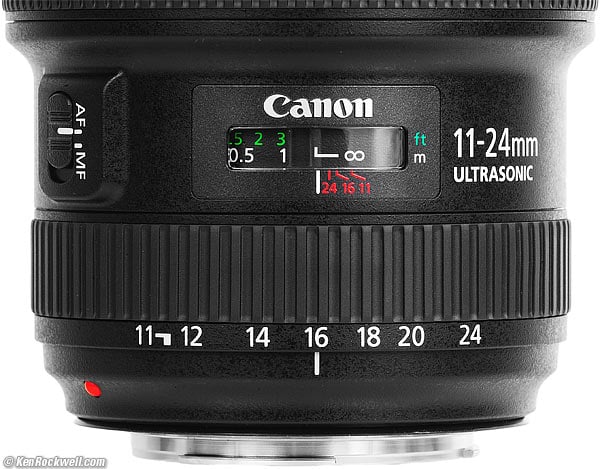
Zoom Ring, Canon 11-24mm f/4L.
The zoom ring is well spaced logarithmically. It's easy to select any precise setting quickly.
Zooming, at least on my brand-new lens, is stiff enough to work best with two fingers. There's a lot of glass to move around, so it takes a very firm finger to zoom if you use only one middle finger.
It zooms just about as well pointed up or down, which is very good.
Compared top
Sample Images Intro Specs Performance
Compared Usage Recommendations More
See also Ultra-Ultrawides Compared and Full-Frame Ultrawide Lenses Compared.
Nothing compares to the Canon 11-24mm f/4 L. It is the world's widest lens. The previous record was held by the Voigtländer 12mm f/5.6 for LEICA and the Nikon 13mm f/5.6. (Fisheye lenses can cover wider angles, but distort horribly and are not used for the same things.)
The Canon 11-24 is a landmark in almost 200 years of photography. Nothing else goes this wide with this little falloff and distortion and stays this sharp, much less does it in an autofocusing SLR lens. This lens is a new benchmark; a new wonder lens.
Versus Canon 20mm f/2.8 USM
20mm/2.8 USM, 17-40mm f/4, 16-35mm/2.8 II, 16-35mm/4 IS and 11-24mm f/4 L. bigger.
The Canon 20mm/2.8 USM is the smallest, lightest and least expensive of the bunch. For general purpose ultrawide use, it also has the most useful single focal length.
The 20/2.8 USM is the lens I carry when I'm traveling light.
Versus Canon 17-40mm f/4
Canon 17-40mm f/4, 16-35mm/2.8 II, 16-35mm/4 IS and 11-24mm f/4 L. bigger.
The Canon 17-40mm f/4 L is the smallest and lightest zoom here.
It's popular, but not comparable; it's a much longer (and more useful) focal length range.
Versus Canon 16-35mm f/2.8 L and L II
Canon 16-35mm f/2.8 II, Canon 16-35mm f/4 IS and 11-24mm f/4 L. bigger.
The f/2.8 lenses are for very different purposes and do not compare.
Both the 16-35mm f/2.8 L and 16-35mm f/2.8 L II are not as sharp and are optimized for sports and news, not for nature, architecture and landscape.
16mm is nowhere near as wide as 11mm; it's like comparing a 50mm lens to a 35mm lens.
Versus Canon 16-35mm f/4 L IS
Canon 16-35mm/4 IS and Canon 11-24mm f/4 L. bigger.
The 16-35mm f/4 L IS is Canon's only other super-sharp ultrawide lens. Only the 11-24 and 16-35 IS are as sharp as each other; every other Canon full-frame ultrawide is inferior.
I usually use my 16-35/4 IS because it's smaller, lighter and takes normal filters — however when carried with my 24-70/2.8 L II (or any other zoom starting at 24mm), the 35mm end of any zoom is wasted duplication. (See Assembling a System.)
16mm is nowhere near as wide as 11mm; it's like comparing a 50mm lens to a 35mm lens.
Versus Canon 14mm f/2.8 L and 14mm f/2.8 L II
Both the Canon 14mm f/2.8 L and 14mm f/2.8 L II are very soft in the corners at larger apertures compared to this 11-24mm. If you care about sharpness, these 14mm lenses are inferior; they are Canon's softest lenses.
The Canon 14mm lenses are from prior decades and were the best you could get for Canon at the time if you needed to go that wide, but today they may comfortably be forgotten — although they are much smaller than this huge 11-24mm. Yes, you could make sharp images with them at f/11, but at larger apertures these were Canon's softest lenses.
Paradoxically even the newer 14mm II still has the foolish 6-bladed diaphragm and isn't that much different optically from the original 14mm, which is why I never bought the -II to replace my 14mm that I still own.
14mm is nowhere near as wide as 11mm; it's like comparing a 50mm lens to a 40mm lens.
Forget these.
Versus Nikon 14-24mm
Canon 11-24mm f/4 L and Nikon 14-24mm. bigger.
The Nikon 14-24mm doesn't work on Canon cameras, so it makes little sense to compare these. They are about the same size, weight and shape.
The Nikon 14-24mm is faster, but doesn't go anywhere near as wide. It came out back in 2007 and has significantly more distortion. It's pretty sharp, but only covers half the zoom range of this Canon. Trying to compare these two is like Nikon trying to get you to buy a Nikon 105-200mm lens compared to a Canon 80-200mm — except that you can't step back and get the same picture!
The 11-24mm has a rear gel filter slot, while there is no good way to filter the Nikon.
This Canon 11-24mm is a significantly more advanced lens, although the Nikon feels a little tougher.
Both this Canon and that Nikon are big ugly things that look nice online and at home, but are big heavy pains to carry around or use all day long since you have to be careful not to bang their fronts on anything. Neither takes front filters, and only the Canon takes rear gel filters.
Versus Nikon 13mm f/5.6
Nikon 13mm f/5.6 and Canon 11-24mm. bigger.
The Nikon 13mm f/5.6 is a collectible and sells for about $24,000 used. It's a very different lens from a different era. It has much less distortion. It takes rear-mounted bayonet filters only, which are included with the Nikon 13mm.
Even if the Nikon 13mm was free, it's so slow (only f/5.6) that the finder is always very dim, making it hard to use indoors.
Sigma 12-24mm
The Sigma 12-24mm is not a professional lens, so it is not comparable. Sigma is not a brand used by real professionals.
I've never bought Sigma because I don't trust that it would last more than several years. I can't afford having a lens die during a shoot, and when you do this for a living, the price of the lens means very little long-term, but its performance and long-term (20 years or more) durability does.
Quality is remembered long after the price is forgotten.
Pros buy lenses and need to them to put out for at least a decade or two; pros don't buy lenses to throw away after 7 years when the warranty runs out.
Usage top
Sample Images Intro Specs Performance
Compared Usage Recommendations More
How to Use Ultrawide Lenses
Ultrawide lenses are the most difficult lenses to use. Amateurs love to buy these, and then take awful pictures because they fail to get close enough and fail to look for the basic structure of the image they are creating and ensure that the basic shapes and balance in their image makes sense. See How to Use Ultra-Wideangle Lenses for much more.
Ultrawides are NOT for "getting it all in." They are for letting you get closer to rub the viewer's nose in something. It takes a strong constitution to get this close to things, and when you do, each millimeter matters in how you position yourself. Move the lens just a fraction of an inch, and the entire composition changes. Just like shooting a rifle, I have to time my breathing just right so my body doesn't move and change my composition.
Please read How to Use Ultra-Wideangle Lenses, otherwise all that most people who get a lens like this do is get shots with huge empty areas on the left, right, top and bottom, and the subject winds up being a tiny thing lost in the middle.
TIP: Keep the front element fastidiously clean. I use a fuzzy microfibre towel I keep in a ziplock bag. The depth of field is so deep at 11mm that the front of your lens will be in focus, and you'll see any dirt in your image! You'll also see fingerprints as darker regions, most noticeable in the sky. Canon suggests a dustblower.
TIP: While it has a slight indentation so it will tend to sit on a table right-side-up, this lens will want to roll and fall off. You might want to put it front-down to prevent this.
Canon's 11-24mm instruction manual
Recommendations top
Sample Images Intro Specs Performance
Compared Usage Recommendations More
Overall
There is no lens on Earth like this, and there never has been. This is the world's widest lens, and it has super-high performance as well.
If you want one, get one.
If you've read this far, you know you want one, and you deserve one. Unlike money spent on camera bodies, money spent on exotic lenses is always a good investment because high performance lenses usually go up in value over time, as well as let you make great images with them all the time. Good lenses are always a better investment than the financial markets, and lenses return the value of letting you use them every day to make pictures, which you stocks don't.
The smart money is always on lenses. See Lens or Camera: Where the smart Money Goes.
Real Estate
This is THE lens for shooting real estate. With this lens, you can make any property look bigger and more open than with any lens from Nikon, or anyone. Likewise, with this lens your shots will make the properties look far more expansive than any of the amateurs shooting Canon 16-35mm or even 14mm L lenses. 11mm is significantly wider than 14mm. Heck, even 13mm used to be much wider than 14mm, and now with 11mm you can make your properties look far bigger and more expansive than anyone else.
Other Roads to Ultra-Ultrawide
Yes, we've always been able to waste hours on a computer and stitch together other shots to try to simulate the look of this lens, but professionals can't afford the time and fooling around and inability to see how the shot will look through the viewfinder. With this lens we can see what we're doing as we do it. We can shoot an entire multi-million dollar property quickly, and be on to the next high-paying gig.
Nature and Landscape
For professional nature and landscape photography, you need this lens to stay ahead of the 10,000 hobbyists who shoot what you do and give it away for free. With digital, every hobbyist with a Nikon, Sony or Samsung already has 300 great shots of Mesa Arch at sunrise in Canyonlands — but none of them go to 11 (millimeters). With this lens at 11mm, you can get there earlier and set up closer, and 1.) get a fresh new perspective no one else has, and 2.) be so close that no one else can get in your way as the busses of amateurs arrive.
More Practical Choices
If you're not a full-time pro who needs this lens to stay competitive, personally I prefer my Canon 16-35mm f/4 IS since it's so much more practical. The 16-35 IS takes front filters and is a lot smaller. As a guy who owns and uses all these crazy lenses, I know that except for interior architecture and the occasional landscape shot, the 11-24mm is just too wide for anything other than for occasional shock value. I know; I've been buying these ultra-ultrawides and fisheyes for myself since the 1970s.
Use on APS-C
It's a waste to buy this magnificent full-frame 11-24mm lens to use only on APS-C. For APS-C, the Canon 10-18mm goes even wider and takes normal filters — for one-tenth the price.
Yes, this lens works swell on APS-C; but it's sort of silly since you're paying $2,700 extra so this 11-24mm can cover full-frame — which you're not using.
It's Inexpensive
Compared to other ways to go this wide, this is the least expensive professional lens to do this. It is a significant step forwards in performance at a bargain price. You can't compare it to 14mm lenses; the closest pro lens is the Nikon 13mm that used to sell new for $10,000 in the 1980s and now sells for $24,000 used, if you can find one. The Nikon 13mm does have the advantage of having less distortion, while it's easy to correct the moderate distortion of this Canon. For $2,999 brand-new, the 11-24mm is a screaming deal, especially if it gives you a professional advantage. See Is It Worth It.
You easily could spend the same price on a camera body — or twice as much for a pro body — and you'll get a few years of use out of that body.
Put this same money into a timeless lens like this, and it will still be cranking out fantastic images 10 or 20 years from now — and when you tire of it, probably will sell this lens in 2035 for more than you paid for it.
$2,999 for a state-of-the-art special-purpose miracle lens like this is a bargain, especially when you realize that it keeps its value over time while you're using it to create great images.
Assembling a System
My usual system is my 16-35 IS, my 50mm f/1.2 L and my 100-400mm L IS II, which cover everything I could ever possibly need. The new 100-400 focusses so close that it replaces both my macro and any 70-200mm. If traveling lighter, I may just bring a 50mm, or my 35mm f/1.4 for low light.
This 11-24mm is a very special-purpose lens, but hold on a minute. Most amateurs carry a 24-105 IS or 24-70/2.8 L II or other midrange zoom starting at 24mm.
If you already have a lens that goes as wide as 24mm, it's redundant to carry another lens that covers the same range, as the 17-40 and 16-35s do. In other words, if your main zoom goes to 24mm, the usual ultrawide choice means you have to buy and carry another lens, but you're only using half its zoom range (16-24mm)
If your main zoom goes to 24mm, it makes some sense to pack this 11-24mm instead of the usual ultrawide zooms. This way you'd cover every millimeter from 11mm to the end of your normal zoom.
If you use a midrange zoom that starts between 24 to 35mm, or are already carrying a 35mm fixed lens, carrying this 11-24mm instead of a regular 16-35mm or 17-40mm actually makes a lot of sense so you don't duplicate focal lengths.
If you already have a fixed 24, 28 or 35mm lens or normal zoom that goes that wide, you might want to carry this ultra-ultrawide instead of an ordinary wide zoom that duplicates these.
You never need to cover every millimeter and never should carry lenses that duplicate focal lengths. It's actually best to leave about a 50% ~ 100% gap between lenses, otherwise you wind up carrying too much and can't move well. If you're tired, you won't be anywhere near as creative and productive.
See also Assembling a System.
Strategic Advantage: Your Secret Sales Weapon
When you show your photos, they'll have more power and depth than other images, which will get you more sales, more referrals and more work.
If I made my living shooting real estate, I wouldn't be telling you to get this lens; I'd be keeping it a secret.
When you get yours, you might want to keep your mouth shut around town. The images at 11mm will speak for themselves. If you have loose lips and your competitors all get these, then you're all back on the same ground. To win in something as competitive as photography, you need every unfair advantage you can get. Don't start an arms race; keep it quiet.
Your clients will see the difference, and they'll know that's it's due to your superior creativity and photography skills and not just your new super-lens.
Getting Yours
I got my 11-24mm at this link to it at Adorama; I'd just as well get it at Amazon or at B&H. For $2,999 you can own a new legend.
If you've found the months I've spent researching and sharing all this, please know that this all-content, junk-free website's biggest source of support is when you use those or any of these links to approved sources when you get anything, regardless of the country in which you live. It helps me keep adding to this free website when you get anything through these links — but I receive nothing for my efforts if you take the chance of buying elsewhere.
Never buy at retail, especially for a lookie-loo lens like this. Canon doesn't seal its boxes so you can't tell if it's a used, returned, damaged, dropped or store-demo lens. Especially with this lens, anyone silly enough to buy at retail has got to know that it's going to have been taken out and played with by everyone in the store before being sold as "new;" while online orders come from secure automated warehouses located far away from any store so no one else gets to drop your lens before you do.
Thanks for your support!
Ken.
More Information top
Sample Images Intro Specs Performance
Compared Usage Recommendations More
How to Use Ultra-Wideangle Lenses
Canon's 11-24mm instruction manual
Canon USA's page on the 11-24mm f/4
Help me help you top
I support my growing family through this website, as crazy as it might seem.
The biggest help is when you use any of these links when you get anything, regardless of the country in which you live. It costs you nothing, and is this site's, and thus my family's, biggest source of support. These places have the best prices and service, which is why I've used them since before this website existed. I recommend them all personally.
If you find this page as helpful as a book you might have had to buy or a workshop you may have had to take, feel free to help me continue helping everyone.
If you've gotten your gear through one of my links or helped otherwise, you're family. It's great people like you who allow me to keep adding to this site full-time. Thanks!
If you haven't helped yet, please do, and consider helping me with a gift of $5.00.
As this page is copyrighted and formally registered, it is unlawful to make copies, especially in the form of printouts for personal use. If you wish to make a printout for personal use, you are granted one-time permission only if you PayPal me $5.00 per printout or part thereof. Thank you!
Thanks for reading!
Mr. & Mrs. Ken Rockwell, Ryan and Katie.
Home Donate New Search Gallery Reviews How-To Books Links Workshops About Contact

